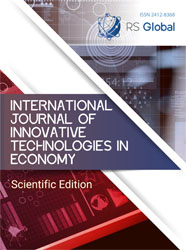THE FORECASTING BUDGET REVENUES IN ARDL APPROACH: A CASE OF UZBEKISTAN
Abstract
This paper contribute to the forecasted total budget revenues in Uzbekistan. It is aim to investigate long run and short run relationship between number of registered company, total number of taxpayers and forecasted total budget revenues from 1998 and 2017. More specifically, this dynamic relationship using bounds testing approach to co integration and the ARDL model. The main empirical findings indicate the existence of directional relationship between the number of registered company and forecasted total budget revenues in short run and long run. This mean that increase the number of registered company leads to go up forecasted total budget revenues. However, a unidirectional relationship between the total number of taxpayers and forecasted total budget revenues are confirmed in the long run and short run.
References
Pesaran, M.H., Pesaran, B., 1997. Working with Microfit4.0: Interactive Econometic Analysis. Oxford University Press, Oxford.
Pesaran, M.H., Shin, Y., Smith, R.J., 2001. Bounds testing approaches to the analysis of level relationships. J. Appl. Econ. 16, 289–326
Robert F. Engle; C. W. J. Granger., 1987. Cointegration and Error Correction: Representation, Estimation, and Testing. Econometrica, Vol. 55, No. 2. pp. 251-276
Johansen, S., 1988, “Statistical Analysis of Cointegration Vectors,” Journal of Economic Dynamics and Control, Vol. 12, No. 2–3, pp. 231–254.
Johansen, S.,1991, “Estimation and Hypothesis Testing of Cointegration Vectors in Gaussian Vector Autoregressive Models,” Econometrica, Vol. 59, No. 6, pp. 1551–1580.
Johansen, S., and Juselius, K., 1990, “Maximum Likelihood Estimation and Inference on Cointegration – with Applications to the Demand for Money,” Oxford Bulletin of Economics and Statistics, Vol. 52, No. 2, pp. 169–210.
Ramazan S., Bradley T. Ewing., Ugur S., 2008, “The relationship between disaggregate energy consumption and industrial production in the United States: An ARDL approach” Energy Economics, Vol. 30 No.1, pp. 2302–2313
Bruce M., 2006, “Causality between economic growth and immigration: An ARDL Bounds testing approach” Economics Letters Vol.90, No.1, pp. 72–76
Nicholas M., 2009, “Energy consumption and economic growth nexus in Tanzania: An ARDL bounds testing approach” Energy Policy, Vol.37, No.1, pp.617–622
Riadh B., Mohamed A., Hatem J., 2017, “Renewable energy consumption, International trade, oil price and economic growth inter-linkages: The case of Tunisia”, Renewable and Sustainable Energy Reviews, Vol.76, No.1, pp.620-627
Soo K., Chung Y., Robert M., 2017, “Re-examining Foreign Direct Investment, Exports, and Economic Growth in Asian Economies Using a Bootstrap ARDL Test for Cointegration” Journal of Asian Economics, Vol., 51, No.1, pp.12-22
Mohaddes, K., Raissi, M., Weber, A., 2017 “Can Italy grow out of its NPL overhang? A panel threshold analysis” Economics Letters, Vol.159, No.1, pp.185-189
Mohammad M., Mohammad A., 2017 “Carbon emissions, energy consumption and industrial growth in Bangladesh: Empirical evidence from ARDL cointegration and Granger causality analysis” Energy Policy, Vol.110, No.1, pp.600-608
Views:
397
Downloads:
529
Copyright (c) 2019 The authors

This work is licensed under a Creative Commons Attribution 4.0 International License.
All articles are published in open-access and licensed under a Creative Commons Attribution 4.0 International License (CC BY 4.0). Hence, authors retain copyright to the content of the articles.
CC BY 4.0 License allows content to be copied, adapted, displayed, distributed, re-published or otherwise re-used for any purpose including for adaptation and commercial use provided the content is attributed.











